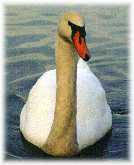
Designated SSSl.
![]()
SWANVALE
 |
CLASSIFICATION Designated SSSl.
|
STATUS
Swanpool has been designated as a Local Nature Reserve and a Site of Special Scientific Interest, in recognition of its importance as a wildlife refuge and public amenity. It is managed by a forum which includes local residents, representatives from Carrick District Council, the Cornwall Wildlife Trust, English Nature, the Environment Agency and the Royal Society for the Protection of Birds.
TYPE OF HABITAT
A small area of mixed wet woodland covering 0.8ha.
ACCESS
OS map ref SW 800 317
Inaccessible, but a public footpath runs alongside from the road running around the back
of the pool at Swanpool, Falmouth.
GENERAL DESCRIPTION
Swanpool has not always been a lake - it was originally an arm of the sea. At some time since the end of the last Ice Age, a shingle bar developed to form a natural dam and Swanpool became a body of fresh water. The road between Swanpool and Swanpool Beach runs across the bar. The water level was then about ten feet higher, so the lake was about three times larger than it is today. This huge lake existed until 1826 when a culvert was constructed through the bar and it drained rapidly.
As the water level fell, the land in the shallower areas emerged as open marshes. From about 1900 onwards, willow and alder trees began to invade the marshes. They eventually created a dense wood to the north and west of Swanpool. Trees are still invading the reeds that fringe the lake, and some may have to be removed to preserve the reedbed in the future.
Water drains out of Swanpool through the culvert to the sea. However, the highest tides rise above the culvert, causing sea water to flow into Swanpool, so the lake is now brackish - a mixture of salty and fresh water. Such brackish lakes are rare habitats in Britain, and they support different animals and plants to freshwater lakes.
SPECIES OF PARTICULAR INTEREST
One very special animal at Swanpool is called the trembling sea mat. It occurs nowhere else in Britain. This small and very primitive creature looks more like a plant than an animal. Resembling a thin layer of jelly at the bottom of the pool, it can only be recognised under a microscope.
The wood is home to a host of plants, in particular the brightly coloured yellow iris and the huge clumps of greater tussock sedge, while the bird life in these areas includes water rail and small flocks of siskin.
 |
Over a hundred types of bird have been seen at Swanpool. Some can be seen easily at a close distance, but binoculars will reveal many more. The familiar moorhen and coot are present throughout the year, and every winter a flock of about 50 tufted duck spends several months on the pool. Occasionally, a kingfisher can be seen as a blue streak, darting across the water at the northern end of the pool. |
HISTORICAL INTEREST
Although there is usually only one pair of swans here now, Swanpool takes its name from these majestic birds. In the 17th century, the Killigrew family is said to have kept swans on the pool.